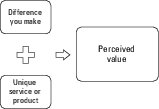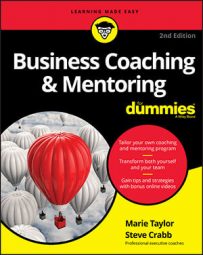- Quality: “We have the very highest standards when it comes to product quality, plus we regularly benchmark John Lewis–branded products against the competition to ensure that we’re not just market-leading in quality, but also on price.”
- Price: “We set highly competitive prices for all our products, with a dedicated team regularly checking them against other high-street [Main Street] competitors.”
- Service: “John Lewis staff are partners in the business, and are highly trained to offer helpful, impartial advice on all products. Our service doesn’t end with your purchase — we provide excellent after-sales and a great choice of expert services to help you, from delivery to installation.”
Many coaches, especially those new to the profession, struggle with valuing what they do and charging for it, often underselling or discounting to get work. The strength of your brand and how it’s perceived affect your price. Also, the price you charge can affect your brand in a negative way. A low price suggests that you’re not in demand and, therefore, aren’t good at what you do.
Value your brand, and price based on the difference you make and not the time you spend, and you’ll earn well.
Realizing your value
The perceived value of your brand equals the sum of the difference you make to your clients and the uniqueness of your products and services. Valuing the difference you make.
Valuing the difference you make.There are three principles to consider when deciding your value:
- Value is determined by the difference you make to the customer and the uniqueness of what you have to offer, compared to the competition. The more difference you make and the more unique you are, the more valuable you are.
- People buy solutions to their needs. The more desperate the needs, the more value your solutions have. Make your business solutions focused.
- People value specialists and experts. Position yourself and your brand as a subject specialist and you add value.
Following a six-step model
Here is a six-step model for having a six-figure coaching practice:- Identify the desperate needs of your potential clients.
Research your market, listen to forums and chat rooms to identify problems, and ask business people what their greatest problems are.
- Identify your needs.
Define your purpose, values, and mission so you’re clear about what type of work best suits you.
- Create a coaching solution to the desperate needs of your clients that satisfies both your needs and theirs.
This approach guarantees a win-win for both you and the client. Think about who the customer is, what pain he experiences, and how you can alleviate that pain.
- Position yourself as a niche specialist in providing the solution.
Use social media, articles, and books to position yourself as an industry expert.
- Market and sell your services.
Find the most cost-effective way to inform people about what you do, and discover how to get them to say yes when you ask for the order.
- Charge appropriately for your services.
If you underprice, it’s a win for the client and a lose for you. That’s not a good recipe for a sustainable business.
Positioning your coaching brand
In the restaurant trade, two extremes are evident — Michelin-star restaurants and burger stands — and a whole range of choices can be made in between. Each caters to a distinctively different market and prices accordingly. They both meet the desperate needs of the hungry, and there is a place in the market for both of them.When deciding where to position your brand, ask yourself the following questions:
- Who are my ideal clients?
- Are they looking for the coaching equivalent of the Michelin-star restaurant or the burger bar experience?
- Determine where your brand fits best and ensure that you price according to the sector you fit into.
 Positioning your valuable services.
Positioning your valuable services.If you choose to offer the burger bar experience, aim to offer the best burger bar experience possible. Some amazing street food vendors are out there, offering outstanding food and service, running respectable businesses, and have long lines of customers who keep coming back for more.
Adjusting your financial thermostat
The main reason coaches fail to charge appropriately is that they have a poor relationship with money. This exercise helps you to readjust and break through any financial fears you may have. Even if you suspect that you have no money issues, do this exercise. We’ve worked with fabulously wealthy clients who, after doing this exercise, have had breakthroughs in earnings and wealth creation.This exercise is called “busting through financial thresholds.”
- Sit down comfortably and review your purpose, values, and mission.
This step primes your mind to consider earning with all actions being aligned to them.
- Think about how money comes your way, and notice how you represent this idea in your mind.
It may be in checks, direct to the bank, by cash, or a combination of all. Consider the quantities and frequency with which money comes your way. You can represent this idea of money in multiple ways, so go with whatever works for you.
- When you have a representation of how money comes in, consider how you represent it going out.
This representation includes money spent on household bills, business outgoings, overheads, holidays, entertainment, and so on.
- When you have a representation for money flowing in and flowing out, double the income.
That’s right. Whatever you generate, imagine it was to double and notice what happens. Common reactions to this idea are “Wow, that would be nice” or “Ugh, that feels uncomfortable.” If you experience a feeling of discomfort, you’ve reached an unconscious threshold. Slightly reduce the amount until it feels comfortable, and sit with that for a moment; then raise it in increments until the amount is doubled.
- When doubling the income, most people see more coming in and more going out, which is understandable, because this increased spending is what most people do.
As they earn more, they spend more.
- Double the amount again.
- If you’re uncomfortable with the amount, repeat the instructions in Step 4.
- Double it again.
As you see money flowing in and flowing out, there comes a point where you see yourself earning more than enough for all the costs of living and the stuff of life, so imagine any excess money going off into investments and projects that align with your purpose and values.
- Double it again, and keep doubling it until the amounts seem ludicrous, even unrealistic.
It can get to the millions and even billions, and you feel comfortable with it.

